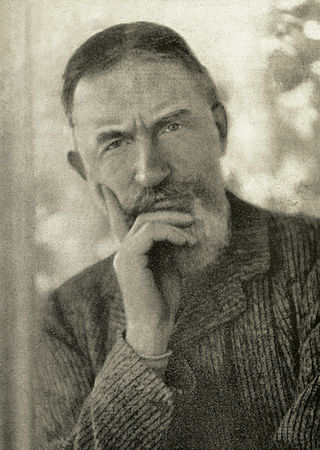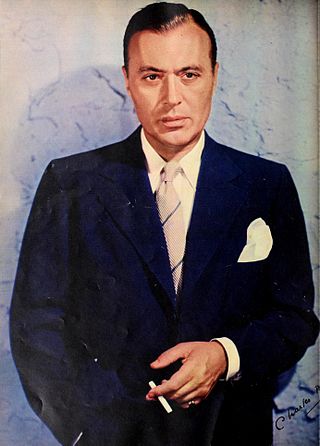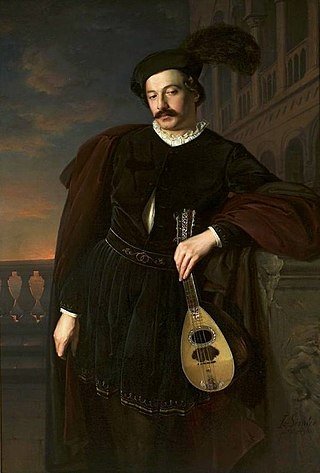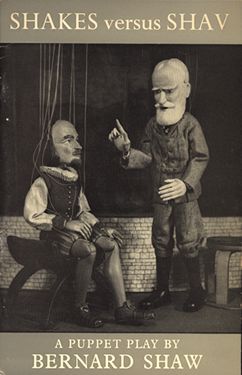
George Bernard Shaw, known at his insistence as Bernard Shaw, was an Irish playwright, critic, polemicist and political activist. His influence on Western theatre, culture and politics extended from the 1880s to his death and beyond. He wrote more than sixty plays, including major works such as Man and Superman (1902), Pygmalion (1913) and Saint Joan (1923). With a range incorporating both contemporary satire and historical allegory, Shaw became the leading dramatist of his generation, and in 1925 was awarded the Nobel Prize in Literature.

Charles Laughton was a British-American actor. He was trained in London at the Royal Academy of Dramatic Art and first appeared professionally on the stage in 1926. In 1927, he was cast in a play with his future wife Elsa Lanchester, with whom he lived and worked until his death.

Charles Boyer was a French-American actor who appeared in more than 80 films between 1920 and 1976. After receiving an education in drama, Boyer started on the stage, but he found his success in American films during the 1930s. His memorable performances were among the era's most highly praised, in romantic dramas such as The Garden of Allah (1936), Algiers (1938), and Love Affair (1939), as well as the mystery-thriller Gaslight (1944). He received four Oscar nominations for Best Actor. He also appeared as himself on the CBS sitcom I Love Lucy.

Don Juan, also known as Don Giovanni (Italian), is a legendary, fictional Spanish libertine who devotes his life to seducing women.

Maurice Herbert Evans was an English actor, noted for his interpretations of Shakespearean characters. His best-known screen roles include Dr. Zaius in the 1968 film Planet of the Apes and Maurice on Bewitched.
Don Juan Tenorio: Drama religioso-fantástico en dos partes is a play written in 1844 by José Zorrilla. It is the more romantic of the two principal Spanish-language literary interpretations of the legend of Don Juan. The other is the 1630 El burlador de Sevilla y convidado de piedra, which is attributed to Tirso de Molina. Don Juan Tenorio owes a great deal to this earlier version, as recognized by Zorrilla himself in 1880 in his Recuerdos del tiempo viejo, although the author confuses de Molina with another writer of the same era, Agustín Moreto.

Harley Granville-Barker was an English actor, director, playwright, manager, critic, and theorist. After early success as an actor in the plays of George Bernard Shaw, he increasingly turned to directing and was a major figure in British theatre in the Edwardian and inter-war periods. As a writer his plays, which tackled difficult and controversial subject matter, met with a mixed reception during his lifetime but have continued to receive attention.
Anne Butler Yeats was an Irish painter, costume and stage designer.

Una O'Connor was an Irish-born American actress who worked extensively in theatre before becoming a character actress in film and in television. She often portrayed comical wives, housekeepers and servants. In 2020, she was listed at number 19 on The Irish Times list of Ireland's greatest film actors.
The Best of Friends is an epistolary play by Hugh Whitemore about the friendship of George Bernard Shaw, Sydney Cockerell and Dame Laurentia McLachlan, based on the lengthy correspondence that passed between them for over 25 years. It was inspired by The Nun, the Infidel, and the Superman, a book by Dame Felicitas Corrigan, a Benedictine nun at Stanbrook Abbey in the U.K.

Lillah, Lady Keeble OBE was an English actress and theatrical manager.
The Shaw Festival is a major Canadian theatre festival in Niagara-on-the-Lake, Ontario, the second largest repertory theatre company in North America. Founded in 1962, its original mandate was to stimulate interest in George Bernard Shaw and his period, and to advance the development of theatre arts in Canada.

Margaret Rawlings, Lady Barlow was an English stage actress, born in Osaka, Japan, daughter of the Rev. George William Rawlings and his wife Lilian Rawlings.

Shakes versus Shav (1949) is a puppet play written by George Bernard Shaw. It was Shaw's last completed dramatic work. The play runs for 10 minutes in performance and comprises a comic argument between Shaw and Shakespeare, with the two playwrights bickering about who is the better writer as a form of intellectual equivalent of Punch and Judy.
Jacqueline A. Smith-Wood is a British actress and director. As an actress she has worked in film, television, theatre and radio.

Douglas Alexander Clarke-Smith, professionally known as D. A. Clarke-Smith or sometimes Douglas A. Clarke-Smith was a British actor. In a stage career lasting from 1913 to 1954, with interruptions to fight in both World Wars, he played a wide range of roles, in modern commercial plays and established classics. He was seen onstage in the West End, on tour in Britain, and on Broadway. In addition to his stage career, he appeared frequently on BBC radio, and was seen in numerous films between 1929 and 1956.
Don Juan in Hell is a 1991 Spanish drama film directed by Gonzalo Suárez. It was entered into the 17th Moscow International Film Festival.

The Shewing-Up of Blanco Posnet: A Sermon in Crude Melodrama is a one-act play by George Bernard Shaw, first produced in 1909. Shaw describes the play as a religious tract in dramatic form.

Gingold Theatrical Group, often abbreviated as GTG, is a New York-based non-profit theatre company. It was founded in 2006 by American actor and director David Staller. Its mission is to present works that carry the humanitarian values of writer and critic George Bernard Shaw. It presents several series, including the annual festival Shaw New York, and the monthly series of staged readings, Project Shaw. Through this series, GTG became the first theatre group to present all 65 of George Bernard Shaw's plays.

Fred O’Donovan (1884–1952) was an Irish actor, early film maker, theatre manager and pioneer of television drama production. For many years he gave the definitive portrayal of the title character in J.M. Synge's The Playboy of the Western World, as well as other prominent roles at Dublin’s Abbey Theatre. He was manager of the Abbey for a time, and appeared in and directed films, television, and on the stage in Britain and abroad before becoming a producer/director in the BBC’s fledgling television service both before and after World War II.














